PHOTOS: UNDERGROUND RAILROAD SITE TOUR
Where Camden County Locals Hid Runaway Slaves
Photos by Hoag Levins

CAMDEN COUNTY, N.J. -- This year's Camden County Historical Society annual trolley tour traced the path of the county's underground railroad sites. Located across the Delaware River from Philadelphia, the region was a 19th-century nexus of transportation routes as well as a hotbed of abolitionist activities. Trolley riders tramped through some of the best-documented local sites that assisted escaped slaves in evading slave catchers and making their way north through the region's Underground Railroad network.
|
|
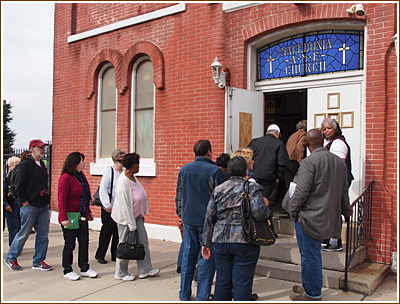
|
|
Trolley participants file into Camden's Macedonia AME Church which in the early 19th-century became the city's first African-American house of worship. Located on Spruce Street in sight of the Delaware River shoreline, it was a safe house for runaway slaves. The current two-story structure, which dates to 1860, has a vibrant congregation that cherishes its history.
|
|

|
|
Inviting trolley tour riders into the second-floor sanctuary, Macedonia officer Ramona Chainey shared stories of the church's historical anti-slavery activities. In one early 19th-century incident, she said, congregation members rushed out into Spruce Street to surround a slave catcher's wagon headed for the shoreline to transport its prisoners across to Philadelphia. The Macedonia crowd set free both those prisoners and the wagon's horses. |
|
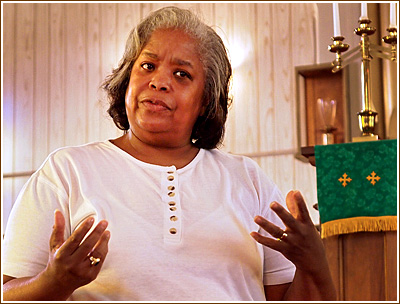
|
|
Ramona Chainey, a member of Macedonia AME for 66 years, explained how the church continues to be a community safe haven offering food programs, outreach to local men's and women's shelters, and summer-long youth programs aimed at keeping children off the city's notoriously mean streets. |
|
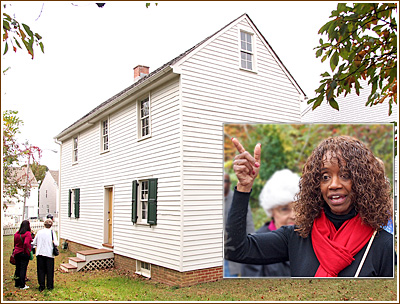
|
|
Nine miles from Macedonia, at the Peter Mott House and Underground Railroad Museum in Lawnside, docent Stephanie Fisher explains that facility's historical role (Fisher was both a Mott House docent and a tour guide on one of the trolleys). Peter Mott was a free Black man who moved from slave-holding Delaware to New Jersey, settling in a remote rural community called "Free Haven" that later changed its name to Lawnside. He became a successful businessman who later risked everything to assist fugitive slaves fleeing north. |
|
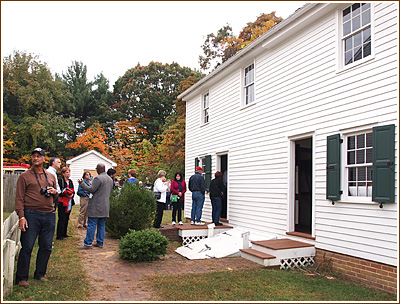
|
|
Trolley riders got to tour the modest Mott House that was slated for demolition in 1989 but saved in a campaign organized by the late Clarence Still, who founded the Lawnside Historical Society that raised the funds to restore the structure as a memorial to Lawnside's historic involvement in the 19th-century battle against slavery. |
|

|
|
The trolley tour passed two important African-American burial grounds: Butler Cemetery at Ferry Ave., and Charles St. in Camden, and Mount Peace Cemetery located behind historic Mount Pisgah Church at Warwick and Mouldy Rds. in Lawnside. Both burial grounds contain graves of many members of the U.S. Colored Troops regiments that, by the end of the Civil War, made up one-tenth of the Union Army. |
|
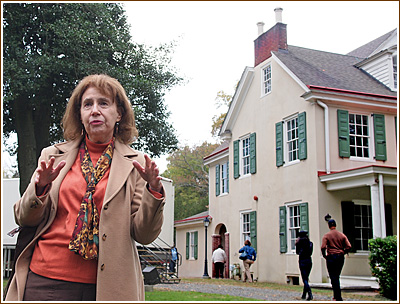
|
|
Nancy Schwartz of the Cherry Hill Historical Commission greeted arriving trolley tour riders to the "Edgewater" mansion, also known as the Kay-Evans house, at Croft Farm off Brace Rd. in Cherry Hill. During the day, fugitive slaves coming from Woodbury were hidden in the 16-room home's attic. Under cover of darkness, the runaways were moved to the next Underground Railroad safe house in Mount Holly. |
|
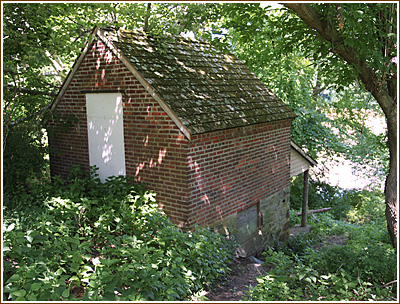
|
|
The Kay-Evans house was the center of a thriving 19th-century grist mill and farming business. The heavily wooded property sat astride the Cooper River; and several of its outbuildings still exist, like this springhouse above. Evans employed free Blacks as workers and, in order to foil local slave catchers, even purchased the freedom of at least two slaves -- Joshua Sadler and Jefferson Fisher. Sadler later established the small village of freed slaves that became known as Sadlertown and still exists as a section of the Haddon Township. |
|

|
|
Taking a break at Croft Farm is trolley rider Raymond Fussell, the official photographer of the Lawnside Historical Society and, in many ways, an interesting part of the local story he has long been documenting. In 1949, when he joined the Air Force, he was part of the last boot camp class that segregated African-American airmen. A geneaologist, he has traced his roots back a century to Fusseltown, a village of free Blacks near White House Pike and Cuthbert Boulevard in what is now Oaklyn. His grandparents once lived in the Mott House and he now lives in Sadlertown, the preserved and wooded hamlet within today's Haddon Township that harbored escaped slaves. |
|
All Rights Reserved, © 2013 HistoricCamdenCounty.com
Contact: editor@HistoricCamdenCounty.com
About this Web site
|
|

|











